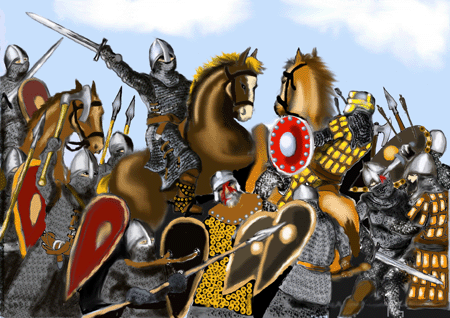The Battle of Hastings
Vydáno dne 02.02.2008
Informace o jedné z nejzásadnějších událostí britské historie, o bitvě u Hastings (1066).
The Battle of Hastings

This battle is probably one of the most important battles, if not events in the British history, because this is the last time the country was conquered by anyone.
Funnily enough, the Battle of Hastings happened in a place called Battle (which is about six miles away from Hastings itself) on 14 October 1066. Harold, the king of England divided his army into three sections and brought it to the site of the battle. His army was just a few more than 5000 tired men, whereas the Norman force consisted of around 15000 infantry, archers and cavalry.
Because of this situation and unbalanced forces, the king could not attack, but had to fight a defensive battle. He had to rely on a wall of shields that his men would hold and hope to break the attacking Normans.
This decision made the opposing side quite worried and the tactic was a great success. Time and again the Norman soldiers threw themselves at the shields, but evidently they couldn't get through (this is shown on the famous Bayeux tapestry that was made at the time). Then, the Norman left flank began to weaken.
The left wing became terrified and panicked. Some foot soldiers and mounted knights began to flee, because rumour of their commander's death began to spread among the ranks. The commander was not dead, and seeing how critical the situation is getting and that his soldiers are running back, chased by the English, met them, and threatened his soldiers with his spear. This tactic seemed to work, and the Normans returned to battle and caused great damage to the English.
It was the turning point of the battle.
The whole incident is shown on the Bayeux tapestry.
Now the English wall had broken, and the Normans were able to get through the cracks. Because such great numbers of the English were lost so quickly, it was now a critical point for them. Harold, along with his two brothers Gyrth and Leofwine soon also fell.
On the tapestry we can see that he is shot in the eye with an arrow, and then trampled into the ground by a Norman horseman. The English army continued to fight bravely even when they realised their king is dead, but the battle was soon lost and they had to retreat. The body of Harold was eventually found. Unfortunately his face was very disfigured and no one could identify him, so the soldiers had to call Harold's concubine Edith Swan-neck so she could help them find out if it was indeed him.
Legend has it that William thanked God for this great victory and decided to repay him by financing the building of the Battle Abbey that stands on the site of the Battle of Hastings. At first, William ordered for the body of Harold to be buried by the battlefield, with a headstone that said, 'Here lies Harold, King of the English', but later, when Harold's name was ruined by Norman propaganda, it was moved to his abbey at Waltham.
Slovíčka z tohoto článku si můžete prostudovat a procvičit zde:
Okruhy slovní zásoby: The Battle of Hastings
Přepis bublinkové nápovědy: